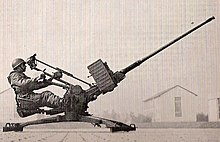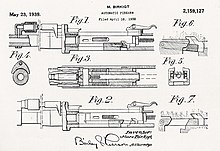Hispano-Suiza HS.404

The Hispano-Suiza Hs.404 was a machine gun in caliber mm 20 and one of the most widely used aircraft on-board weapons of the 20th century. It was manufactured in Bois-Colombes (France) by Société Française Hispano-Suiza , a subsidiary of the Barcelona- based automobile company Hispano-Suiza , and was used by British , American and French armed forces, among others . The movable version was named HS.405.
The relatively light with 45 kg of 50 weapon missed 20-mm explosive rounds , more effective than the machine gun - ammunition were what made the HS.404 the ideal board armament for aircraft. In the 1930s it replaced the Browning MGs , which were widely installed in fighter planes and only fired .303 British (7.7 mm) caliber projectiles .
The Israeli army used the HS.404 in their TCM-20 - anti-aircraft guns .
development
After the First World War, Hispano-Suiza manufactured Oerlikon FF machine cannons under license under the designation HS.7 and HS.9 for the French Armée de l'air at the Bois-Colombes plant . These differed only in the suspension from the 20 mm Oerlikon recoil loaders with an unlocked ground lock .
From 1933 Marc Birkigt started his own development, which was designed as a gas pressure loader with a support flap lock and additionally accelerated the lock after unlocking with the residual pressure in the barrel. The inventor Marc Birkigt called this system a combination between a locked gas pressure charger and an unlocked mass lock in the second phase (English: gas and blow-back) and thus achieved a rate of fire ( cadence ) that was 200 rounds per minute higher than the Oerlikon FF. He had his system patented in the late 1930s.
Two years after the start of the Spanish Civil War left Marc Birkigt his company and founded in 1938 in Geneva , the Hispano-Suiza (Suisse) SA Its subsidiary British Manufacture and Research Company (BMARC) based Grantham (Lincolnshire) also presented the HS.404 for Allies here.
Compared to the Oerlikon, this weapon, now called Hispano-Suiza 404 , had a slightly increased muzzle velocity in addition to the higher rate of fire . The Type 404 or HS.404 has long been considered the best on-board weapon of its kind. It was often installed in French and Swiss fighters, where it was mounted between the rows of cylinders of the Hispano-Suiza-12Y aircraft engines and shot through the hollow propeller shaft - an arrangement known as the "Moteur-Canon" (motor cannon). The ammunition was fed through a drum magazine with a capacity of 60 rounds . This supply turned out to be too small. In 1940 Hispano-Suiza therefore developed a belt ammunition feed similar to that for the heavier derivatives of the HS.404 in 23 mm caliber. With the occupation by the German Wehrmacht in June 1940, the development in France was stopped, but continued in Switzerland. The HS 404 served not only as an on-board cannon, but was also used as a light anti-aircraft cannon on suitable mounts.
Meanwhile, Great Britain secured the license to build the HS.404, which was first used as Hispano Mk.I in the Westland Whirlwind . British engineers developed a belt-guided ammunition feed. The so-slightly modified gun was in both the RAF and the FAA as Hispano Mk.II used. Four of these guns each replaced the eight 7.7 mm Browning M1919 machine guns of .303 British caliber in the Hawker Hurricane and in the tropical version of the Supermarine Spitfire ; the weapon became the standard armament of all later models. Most of the other Spitfires had technical difficulties - the cannons were unheated because of the room; This led to icing up at great heights and thus to failure - only two cannons on the inside in combination with four 7.7 mm MGs or two 12.7 mm Browning M2 ( .50 BMG ) in the wings.

In the USA, the weapon was manufactured under license as the M1 , with both the United States Army Air Corps (USAAC) and the US Navy planning to switch to the 20 mm caliber as soon as production capacities allowed it. Large-scale production of the weapon and its ammunition was planned for 1941. During the tests, the weapons were found to be extremely unreliable; a significant number of misfires occurred because the cartridge ignited with a light blow from the firing pin. The British were interested in the weapon in order to relieve domestic production, but they were disappointed with the test results. In April 1942 a copy of the British Mk.II was sent to the USA for comparison. The main difference between the two was that the British version had a slightly shorter chamber .
The Americans refused to modify the chamber, but made some changes to the design to make it a more reliable M2 . By the end of 1942 the United States Army Air Forces (USAAF) had stored 40 million rounds of 20 mm ammunition, but the weapon remained unacceptable. It was not until December 1945 that the American Chief of Ordnance suggested that additional changes be made to the design in order to make the weapon ready for use.
In the meantime, the British had written off the US version and increased their own production capacities to such an extent that this matter was no longer an issue. The weapon was further redesigned to become the Hispano Mk. V , which featured a shorter barrel, lighter weight, and higher cadence at the expense of a lower muzzle velocity . One of the main British fighter jets that the Hispano Mk.V used was the Hawker Tempest Mk.V Series II , which used four Hispano cannons. The Americans followed this development with the M3 , but the reliability problems persisted. After World War II, the USAF adopted the M3 as the M24 , which was identical to the M3 except for the electrical ignition . The British Mk V and American M3 / M24 guns were lighter and had a higher rate of fire than the previously manufactured HS.404. The same applies to the HS.404 cannons, which were further developed after the Second World War, which were manufactured under license under the designation HS.820 in Geneva, but also at Rheinmetall in Germany.

These weapons were quickly replaced by the newly introduced revolver cannons, which were based on the German MG 213 ( Note : "Revolver cannon" does not mean the Gatling cannon , but the principle analogous to the Mauser BK-27 ). The British introduced the high- penetration ADEN cannon in most post-war aircraft , the French introduced the fairly similar DEFA cannon , both with the same ammunition, and Sweden used 30mm KCA manufactured at Hispano-Oerlikon (Genève) SA for the Saab Viggen . Revolver cannons with a rate of 1400 rounds / min. ( Note : The weapons division of Hispano-Suiza (Suisse) was taken over by Oerlikon-Bührle in 1970 ). The USAF replaced the M24 with the M 39 revolver cannon in 20 mm caliber, while the US Navy combined the original Hispano design with a new, lighter cartridge to form the Colt Mk-12 cannon in order to achieve a higher muzzle velocity.
application
Argentina
- HS.804
France
- HS.404
Great Britain
- Hispano Mk. I
- Hispano Mk. II
- Blackburn Firebrand
- Bristol Beaufighter
- CAC Boomerang
- Consolidated Liberator GR I
- de Havilland DH.98 Mosquito
- Douglas Boston III (Intruder)
- Fairey Firefly
- Gloster Meteor
- Hawker Hurricane
- Hawker Typhoon
- North American Mustang IA
- Supermarine Spitfire
- Hispano Mk. V
- de Havilland Hornet & Sea Hornet
- de Havilland DH.100 vampires
- de Havilland Venom & Sea Venom
- English Electric Canberra B.Mk.6 & B (I) .Mk.8
- Hawker Fury & Sea Fury
- Hawker Sea Hawk
- Hawker Tempest
- Martin-Baker MB5
- Supermarine Attacker
- Supermarine Seafang
- Supermarine Spiteful
- Supermarine Spitfire - Marks 21 and later
- Westland Welkin
- Westland Wyvern
Yugoslavia
- HS.404
Sweden
- HS.804
United States
- M1
- M2
- Bell P-400 (P-39 Airacobra, export)
- Boeing B-29 Superfortress
- Lockheed P-38 Lightning
- Northrop P-61 Black Widow
- Chance Vought F4U-1C Corsair
- M3
- Chance Vought F4U-4B Corsair and subsequent versions
- Chance Vought F6U Pirate
- Chance Vought F7U Cutlass
- M24
Technical specifications
- Type : single barrel machine gun
- Caliber bullet : 20 mm × 110 mm
- Type : gas pressure charger
- Length : 2.36 m
- Weight (complete) : 42–50 kg
- Cadence : 600-850 rounds per minute (rpm)
- Muzzle velocity : 840–880 m / s (depending on the pipe length)
- Bullet weight : 130 g
- Explosives content : ~ 6 g
Similar weapons
| Surname | cartridge | Bullet weight |
cadence | Muzzle velocity |
Gun weight |
|---|---|---|---|---|---|
| (Grams) | (rpm) | (m / s) | (kg) | ||
| France | |||||
| HS.9 | 20 × 110RB | 122 | 360-420 | 830 | 48 |
| Hispano-Suiza HS.404 | 20 × 110 | 130 | 700 | 880 | 60 |
| Germany | |||||
| MG FF | 20 × 80RB | 134 | 520 | 600 | 28 |
| MG FF / M | 20 × 80RB | 92/115 | 540/520 | 700/585 | 28 |
| MG 151/20 | 20 × 82 | 92/115 | 750-800 | 800/720 | 42 |
| Japanese army | |||||
| Type 94 flexible | 20 × 99RB | 127 | 380 | 675 | 43 |
| Ho-1 | 20 × 125 | 144 | 400 | 805 | 45 |
| Ho-3 | 20 × 125 | 144 | 400 | 805 | 45 |
| Ho-5 | 20 × 94 | 96 | 750-850 | 715 | 37 |
| Japanese Navy | |||||
| Type 99-1 | 20 × 72RB | 129 | 520 | 525 | 26th |
| Type 99-2 | 20 × 101RB | 128 | 490 | 750 | 34 |
| Great Britain | |||||
| Hispano Mk.II | 20 × 110 | 130 | 600 | 880 | 50 |
| Hispano Mk.V | 20 × 110 | 130 | 750 | 840 | 42 |
| Soviet Union | |||||
| SchWAK | 20 × 99R | 95 | 800 | 750-770 | 42 |
| Beresin B-20 | 20 × 99R | 95 | 800 | 750-770 | 25th |
Web links
Individual evidence
- ^ Heinz J. Nowarra: The German Air Armament 1933-1945. Vol. 4, p. 129.
- ↑ Powder shot . In: Der Spiegel . No. 42 , 1970 ( online ).

